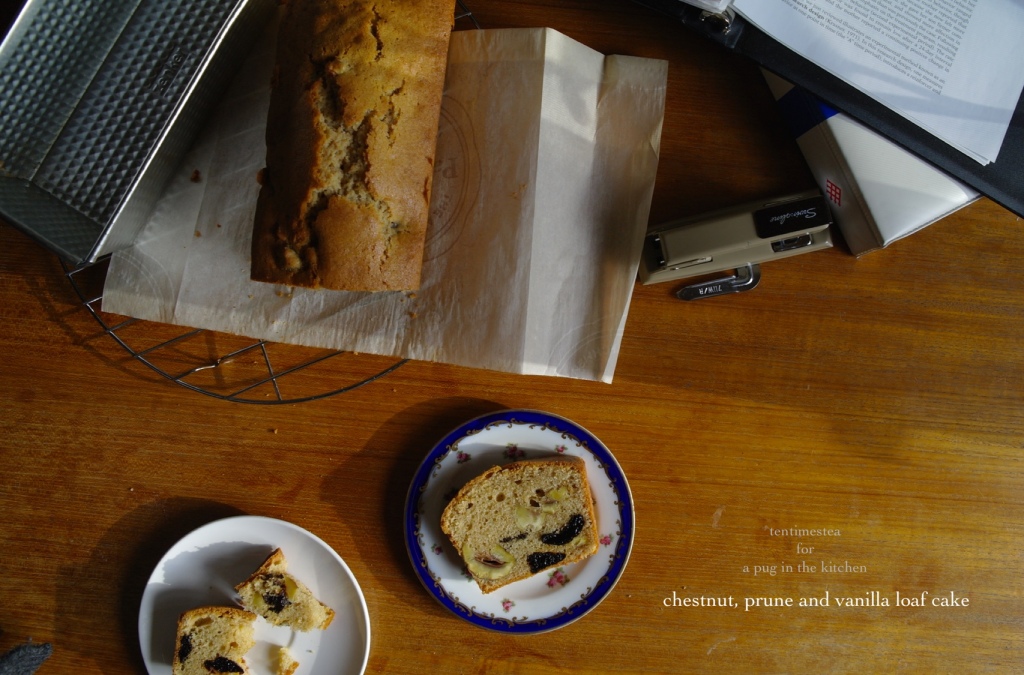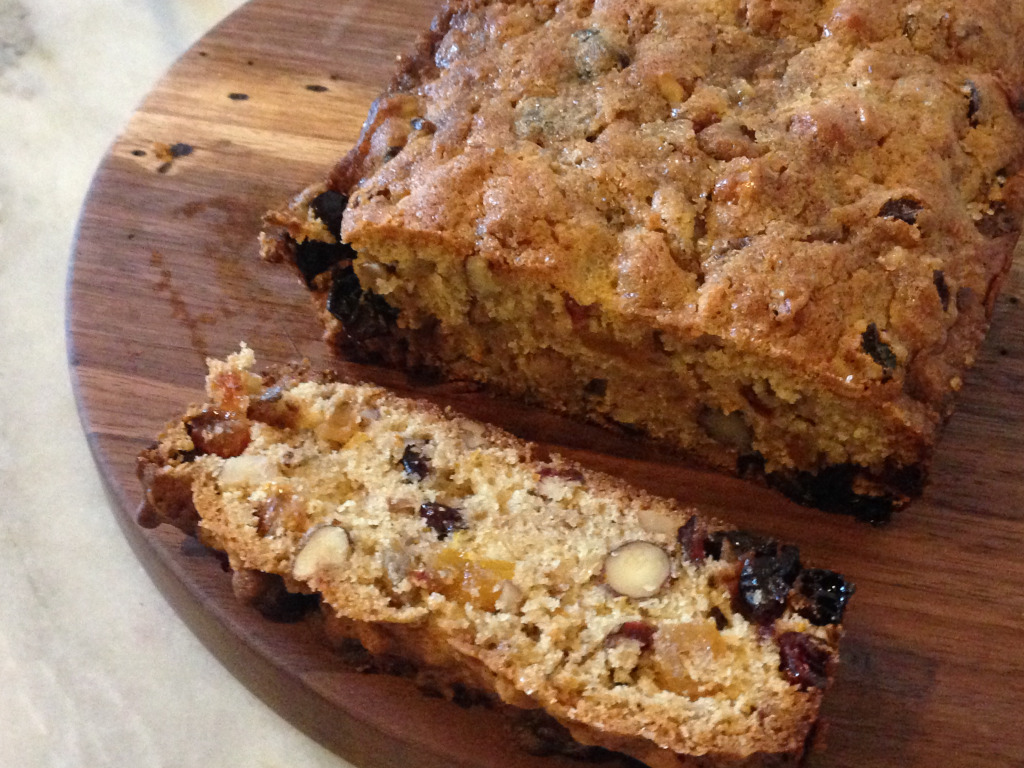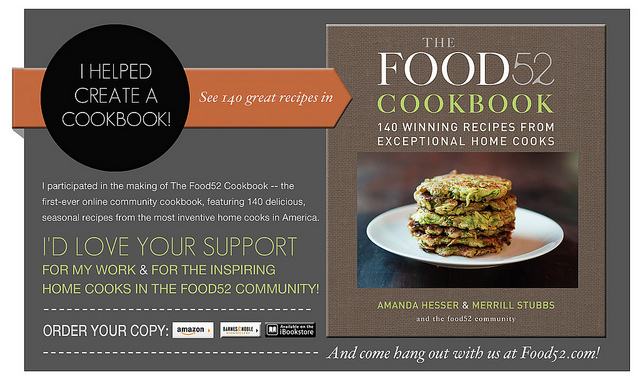
A few months back I was thrilled when Laurie whose gorgeous blog Ten Times Tea agreed to do a guest post. Her timing is impeccable because this loaf just screams holidays. She is uber talented with such creativity, I love her photographs and her no nonsense writing style. Thank you so much Laurie for doing this post for me and wish you and yours a very Happy Holiday. I love the way Laurie experiments and even though she may not admit it I think her results are outstanding, she loves to use whole grains giving her baked goods a healthy twist. Can’t wait to try this, thank you for your kind words and take it away Laurie…..
Suzanne’s experience, attention to flavour, and warm style comes through in everything she makes and blogs about. And, unlike some food bloggers that I tend to admire from afar, Suzanne’s blog demands a pause, taking time to comment and marvel and laugh and sometimes even commiserate.
I was so happy to be to have the opportunity to put together a guest post. Though I was also a bit conflicted: what makes us quite different is that Suzanne’s recipes simply ooze with experience and certainty, exactly what my recipes typically lack. My blog is all about the baking (unfortunately or otherwise), and frankly, leans more towards a “log” of what disasters and otherwise I’ve been baking, rather than a reliable source of recipes. But despite this, Suzanne has been so supportive of my experiments and even the most dismal failures.

I wasn’t sure I would be able to make anything worthy of a guest post…but then, enter this cake. This cake is fabulous. I’m still in awe. It’s based on the brown butter and vanilla weekend cake in one of Dorie Greenspan’s books, Baking Chez Moi. Would you expect anything else from Dorie?
The cake is unabashedly rich, the crumb possessing a buttery sheen, and is incredibly fragrant due to an incredible quantity of vanilla extract and browned butter. I’ve made merely superficial changes, but I highly advocate them. The prunes and chestnuts, which are two of my favourite things, are homely and warm, while still somehow glamorous in my vague imagination of 20th century whiskey glasses and pâté and feather boas. (Ah, this imagination sometimes.) They simply fit perfectly into the backdrop of a dense and vanilla-heady cake, such that even a friend who does not at all subscribe to my obsession with prunes admitted that really, they did seem to work quite well.
I also made a couple more characteristic changes, reducing the sugar and using part whole spelt flour. I wanted to use these changes to transition into writing about some general themes in baking and my approach. As Suzanne recently wrote about, lately she’s switched her eating focus. It made me think a bit about this whole baking thing—what choices I make, what I minimize and maximize, and why. But after writing it, I looked back and felt so pretentious, with these meanderings on sugar and whole grains.
The thing is, I find there are many valid perspectives when it comes to baking. And thus many valid styles of baking, which result in many, many delicious baked goods. I enjoy them all. There is nothing superior about any approach over others. Some days call for Smarties-dotted blondies just as much as other days call for raw vegan coconut oil and date squares. So I hope everything here can be taken with several grains of salt—it’s one vague approach to baking. I guess I like it so I seem to advocate for my view, but it doesn’t mean I always stick to it.

Sugar
Sugar is something I do not try to eliminate, but I find I can typically reduce the sugar content of baked goods with little consequence. This isn’t to validate desserts or bolster excuses for eating more (well, at least I try not to do that…). But I do occasionally bake for some diabetics, and in general, if I can reduce the sugar, I think I may as well.
In fact, I do think that most desserts don’t require too much sweetness for it to still taste like dessert. I’m a bit of a cake-person as opposed to a candy-person (a very important dichotomy), where I like more moderate sweetness padded with plenty of substance and textures and other flavours. Better yet, baking can quite often fit into that ambiguous breakfast/tea sort of category as well, which entails the same richness and decadence with noticeably less sweetness. Another trick is to use sweet-associated flavours like warm spices, or plenty of fresh fruit.
I find it’s worthwhile to experiment! A 25-50% reduction in the sugar is a good place to start, at least in cases where the sugar is not a structural necessity (I’ve tried to push it unsuccessfully with meringues and buttercreams). However, in the end you may just find that sugar reductions compromise golden crusts or perfect textures. It always depends on what you’re looking for, and reductions may not be worth it.


Whole grains
Recently I made a cake that used only white flour, and I was surprised—it tasted bland all of a sudden. I suppose it’s because in recent years, whole wheat and spelt flour have become my go-to, some somehow now taste rather “neutral.”
I refrain from using this idea of whole grains as a gateway to a certified healthy label. It’s a bit of a false rhetoric because 1) we are still talking dessert and 2) I don’t push the envelope very far. The whole grains are primarily for flavour, and I like to prioritize structure as well. (On this note, I admire the ingenuity, innovation and persistence of gluten-free bakers!) Thus, something may be only a quarter whole spelt flour, but it will taste nutty and warm and complement spices or dried fruit. Whole wheat flour is very suitable for crumbles and oatmeal cookies. I find buttery and salted whole wheat pastry perfect for tarts, and while scones have been a perpetual struggle for me, I recently made some fluffy scones with half whole wheat pastry flour.
As far as pastry-type experimentation goes (bread is a bit iffier), I think whole wheat flour can be successfully subbed for 50-100%. Spelt flour, I would normally not go above 50% due to the lower gluten content. Buckwheat and rye I usually try at 25-20% due to their low gluten content and stronger flavours. In the end, though, it does depend on what you’re making. Sometimes white flour is the best.

This cake is a rich and buttery and sugary glory, and in no way do my changes make it at all healthy…but I like the cake even more for the changes I did make. It is only moderately sweet, with spelt flour to complement the prunes and pick up on the warm notes of the roasted chestnuts and browned butter.
So happy baking! With the approaching holidays, I’m sure there will be plenty of baking going on.

prune and chestnut vanilla loaf cake
Based on Dorie Greenspan’s brown butter and vanilla bean weekend cake in Baking Chez Moi. Instead of part vanilla bean and part vanilla extract, you can use either: 1 whole vanilla bean or 4 tsp vanilla extract as detailed by the original recipe. I would also consider increasing the quantity of prunes and chestnuts to 150 g each.
1 stick butter
100 g whole spelt flour
138 g all-purpose flour
scant 1/2 tsp kosher salt
1 1/2 tsp baking powder
175 g granulated sugar
3-cm length of vanilla bean
4 eggs
2 tsp vanilla extract
1/3 c (80 mL) heavy cream
1 capful dark rum
100 g dried prunes
100 g roasted and peeled chestnuts, whole and broken into rough pieces
Preheat the oven to 350F. Butter a loaf pan and line with a sling of parchment paper.
Brown the butter in a small saucepan, cooking until deep golden and nutty, and then set aside.
Whisk together the flours, baking powder and salt.
Place the sugar in a large bowl. Split the vanilla bean and scrape the seeds out into the sugar and rub in. Add the split vanilla bean and rub in the sugar as well to remove any excess seeds (this can then be placed in the sugar bowl for vanilla sugar and the like). Add the eggs and whisk until thoroughly combined. Follow with vanilla extract, the heavy cream and rum, whisking until combined.
Add the dry ingredients in two additions, folding in with a rubber spatula. Next, fold in the butter in three additions. Lastly, mix in the chestnuts and prunes. Scrape into the prepared pan and bake for 60 minutes or until an inserted skewer is removed clean.
Let cool on a wire rack.



































